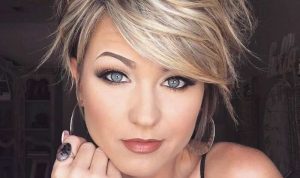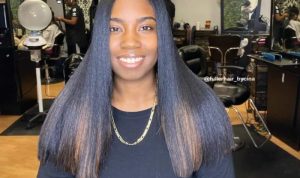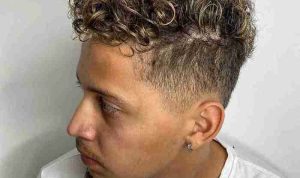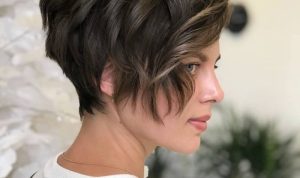Popular Natural Hairstyles for Black People
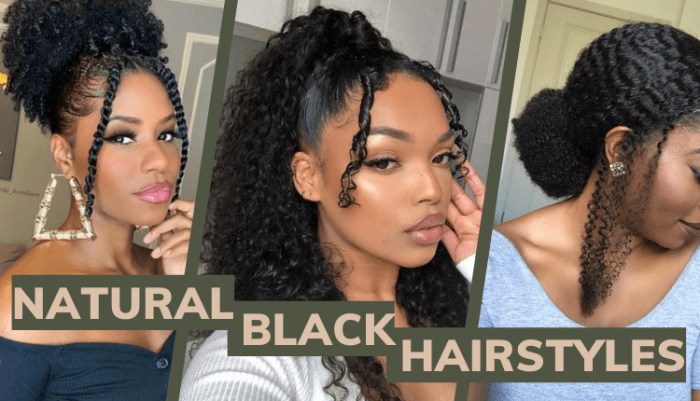
Source: amazonaws.com
Hairstyles for black people with natural hair – Natural hair offers a vast spectrum of styling possibilities, reflecting individual preferences and cultural heritage. This section explores popular and trending hairstyles, categorized by hair length and texture, alongside a glimpse into the rich cultural significance of some traditional styles.
Popular Natural Hairstyles by Length
The following table showcases ten popular natural hairstyles categorized by hair length, considering face shape suitability and maintenance requirements.
| Hairstyle Name | Description | Best Face Shape | Maintenance Level |
|---|---|---|---|
| Short: TWA (Teeny Weeny Afro) | A very short, natural afro. | Oval, Round | Low |
| Short: Cropped Cut | A short, styled cut with defined edges. | Oval, Heart | Medium |
| Short: Finger Coils | Tight coils created using fingers. | Most face shapes | Medium |
| Medium: Shoulder-Length Afro | A fuller afro that reaches the shoulders. | Oval, Round | Medium |
| Medium: Twist-Outs | Defined curls achieved by twisting damp hair and letting it dry. | Most face shapes | Medium |
| Medium: Bantu Knots | Small, neat knots throughout the hair. | Oval, Square | Medium |
| Long: Long Box Braids | Long, thin braids extending down the back. | Most face shapes | Low (once installed) |
| Long: Locs | Matted strands of hair, either free-flowing or styled into updos. | Most face shapes | Low (once established) |
| Long: Goddess Braids | Large, chunky braids often incorporated with beads or other adornments. | Most face shapes | Low (once installed) |
| Long: Protective Styles with Extensions | Various styles using extensions to add length and volume. | Most face shapes | Low (once installed) |
Trending Natural Hairstyles in 2024
Five trending natural hairstyles in 2024, along with their styling techniques, are highlighted below. These styles are influenced by current fashion trends and a growing appreciation for versatility and ease of styling.
- Double Bantu Knots: This style involves creating two larger Bantu knots, often positioned higher on the head. Styling involves sectioning the hair into two halves and twisting each section into a knot. A good hold gel or mousse helps maintain the style.
- Mini Twists: Smaller twists offer a more intricate look than traditional twists. Styling requires precise sectioning and careful twisting of damp hair using styling cream or gel for definition and hold.
- Passion Twists: These twists use extensions to create a fuller, longer look. Styling involves braiding or twisting extensions into the natural hair. The technique requires practice and patience.
- Space Buns: High, positioned buns on either side of the head. This style requires creating two high ponytails and twisting the hair into buns. Hair ties and bobby pins are necessary.
- Sleek Low Bun: A chic, minimalist look perfect for formal occasions. Styling involves smoothing the hair with a gel or edge control product and creating a low, tight bun at the nape of the neck.
Cultural Significance of Traditional African Hairstyles
Traditional African hairstyles carry deep cultural and historical meaning, often signifying status, age, marital status, or tribal affiliation. Their modern interpretations demonstrate the enduring influence of these styles.
- Cornrows: Historically used for adornment and practicality, cornrows were (and still are) a way to manage hair and express individuality. Modern interpretations range from intricate patterns to simpler styles.
- Fulani Braids: Originating from the Fulani people of West Africa, these braids often feature intricate patterns and decorative elements. Modern interpretations often incorporate beads and other embellishments.
- Dreads/Locs: A style with ancient roots across various African cultures, locs are now a globally recognized and diverse style with many variations.
Hairstyles Based on Hair Texture
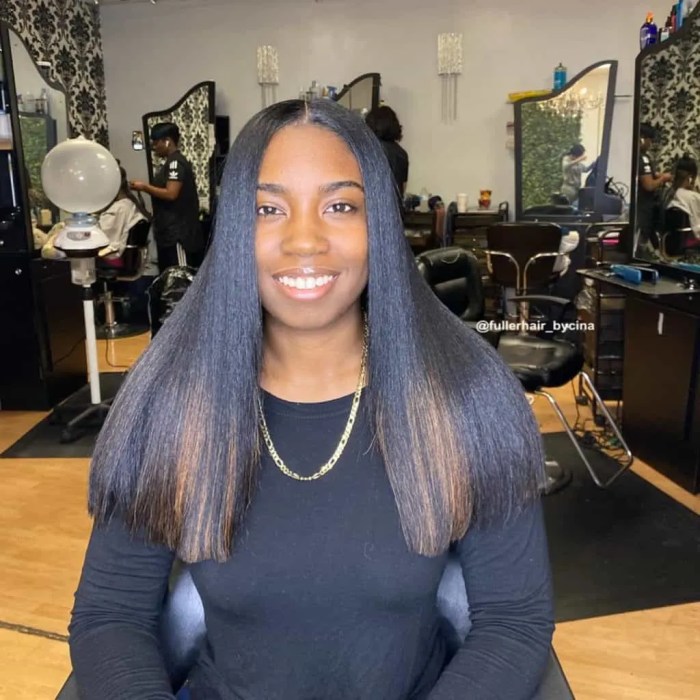
Source: blackbeautybombshells.com
Natural hair textures vary greatly, impacting the suitability of different hairstyles. This section provides a guide to matching hair textures with appropriate styles, along with product recommendations.
Hair Texture Classification and Suitable Hairstyles
Understanding your hair texture is crucial for choosing the right hairstyles and products. The following guide classifies hair textures and suggests suitable styles.
- Type 3 (Wavy): 3A (loose waves), 3B (medium waves), 3C (tight waves)
-Styles like twist-outs, braid-outs, and wash-and-gos work well. - Type 4 (Curly/Coily): 4A (fine, tightly coiled), 4B (medium, tightly coiled), 4C (dense, tightly coiled)
-Styles like afros, bantu knots, box braids, and locs are suitable.
Comparison of Hairstyles for Different Hair Textures
Fine hair often requires gentler styling techniques to avoid breakage, while medium and coarse hair can handle more robust methods. Fine hair may benefit from styles that add volume, while coarse hair can support heavier styles like braids or locs.
Styling Products for Different Hair Textures
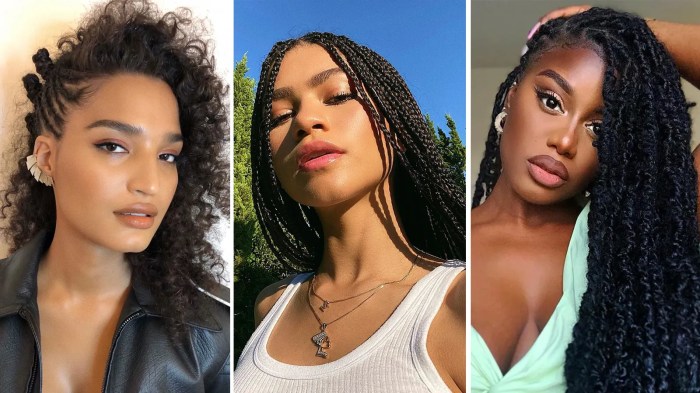
Source: glamour.com
Selecting the right products is essential for maintaining healthy and manageable natural hair. Each hair texture type benefits from different products.
- Fine Hair: Lightweight mousses and gels provide hold without weighing hair down.
- Medium Hair: A balance of moisturizing and styling products is ideal, such as creams and leave-in conditioners.
- Coarse Hair: Rich, moisturizing products like butters and oils are beneficial for hydration and manageability.
Protective Styling Techniques
Protective styling techniques help minimize manipulation and breakage, promoting hair growth and health. This section details three protective styling methods, a step-by-step guide for box braids, and long-term effects.
Protective Styling Methods
These methods offer various benefits and potential drawbacks depending on individual hair and scalp conditions.
- Box Braids: Offer length retention and low maintenance but can cause tension headaches or scalp irritation if too tight.
- Cornrows: Similar benefits to box braids, with the added advantage of being less time-consuming to install.
- Twists: A gentler protective style than braids, offering good length retention and minimal tension.
Step-by-Step Guide for Creating Box Braids
Creating box braids requires precision and patience. This guide Artikels the process.
- Prepare hair: Wash, condition, and detangle hair thoroughly.
- Section hair: Divide hair into small, square sections.
- Apply braiding hair: Attach braiding hair to each section.
- Braid each section: Braid tightly and securely.
- Secure ends: Secure the ends of each braid with rubber bands.
Long-Term Effects of Protective Styling
Protective styling offers both advantages and potential drawbacks for long-term hair health. Proper installation and maintenance are key to maximizing benefits and minimizing risks.
Exploring hairstyles for Black people with natural hair offers a wealth of creative options, from intricate braids to voluminous afros. A fantastic resource for inspiration is the website dedicated to african hair natural hairstyles , showcasing a diverse range of styles. This site provides excellent examples to help you discover the perfect look to complement your unique features and enhance your natural beauty, ultimately inspiring your next natural hair journey.
- Positive: Length retention, reduced breakage, minimized manipulation.
- Negative: Potential for scalp irritation, hair loss due to tension, damage from improper installation.
Hair Care and Maintenance
Maintaining healthy natural hair requires a consistent routine and attention to detail. This section provides a hair care routine, addresses common hair problems, and explains proper detangling techniques.
Healthy Natural Hair Routine
This routine focuses on cleansing, conditioning, and deep conditioning to maintain healthy hair.
- Wash hair weekly or bi-weekly with a sulfate-free shampoo.
- Condition hair after each wash with a moisturizing conditioner.
- Deep condition hair once a week or every other week to add moisture and strength.
- Moisturize daily using a leave-in conditioner or hair oil.
- Protect hair at night with a satin bonnet or scarf.
Common Natural Hair Problems and Solutions
Several common problems can affect natural hair. Addressing these issues promptly can help maintain hair health.
- Breakage: Use gentle detangling techniques, minimize heat styling, and moisturize regularly.
- Dryness: Deep condition regularly, use moisturizing products, and limit exposure to harsh elements.
- Dandruff: Use an anti-dandruff shampoo, maintain a clean scalp, and consider using essential oils.
- Product Buildup: Clarify hair regularly with a clarifying shampoo.
- Ingrown Hairs: Exfoliate regularly, use a gentle cleanser, and avoid harsh scrubbing.
Proper Detangling Techniques
Detangling natural hair correctly minimizes breakage. Using the right tools and techniques is crucial.
- Start from the ends and work your way up.
- Use a wide-tooth comb or detangling brush.
- Apply a detangling product to make the process easier.
- Be gentle and patient.
Styling Products and Tools
Choosing the right styling products and tools is essential for achieving desired hairstyles and maintaining healthy natural hair. This section highlights essential products and tools, along with their uses and benefits.
Essential Styling Products
These products are crucial for managing and styling natural hair.
- Leave-in Conditioner: Provides moisture and detangles hair.
- Moisturizing Cream: Adds hydration and helps define curls.
- Hair Oil: Seals moisture and adds shine.
- Gel: Provides hold and definition.
- Edge Control: Smooths edges and flyaways.
Hairbrushes and Combs
Different brushes and combs serve various purposes in natural hair care.
- Wide-tooth comb: Detangles wet hair.
- Denman brush: Defines curls and waves.
- Paddle brush: Smooths hair and detangles.
Heat Styling Tools
Heat styling tools can be beneficial but should be used sparingly to avoid heat damage.
- Benefits: Creates sleek styles, adds volume.
- Drawbacks: Can cause dryness, breakage, and heat damage.
- Safe Usage: Use a heat protectant, avoid high heat settings, and don’t overuse.
Hairstyles for Different Occasions
Natural hair can be styled for various occasions, from formal events to everyday wear. This section provides hairstyle suggestions for different settings and weather conditions.
Formal Hairstyles
These styles are suitable for formal events, offering elegance and sophistication.
- Sleek Updo: A polished, pulled-back style with a defined shape, often achieved with gel or hairspray.
- Elegant Braids: Intricately braided styles, possibly incorporating beads or other embellishments, create a refined look.
- Twisted Updo: A more relaxed updo, using twists to create volume and texture.
Everyday Hairstyles, Hairstyles for black people with natural hair
These styles are quick, easy, and practical for everyday wear.
- High Puff: A quick and simple style, ideal for busy mornings.
- Low Bun: A classic and versatile style, easily adaptable for various occasions.
- Headwrap: A stylish and protective way to style hair quickly.
- Half-Up Half-Down: A simple style that combines the practicality of an updo with the elegance of loose hair.
- Wash and Go: A no-fuss style that emphasizes natural texture and requires minimal styling.
Adapting Hairstyles for Weather Conditions
Adjusting hairstyles to suit different weather conditions can prevent damage and maintain style.
- Humidity: Use anti-humidity products or protective styles to prevent frizz.
- Cold Weather: Protect hair from the cold and dryness with hats, scarves, and moisturizing products.
Essential FAQs: Hairstyles For Black People With Natural Hair
What is the best way to prevent breakage in natural hair?
Gentle detangling using a wide-tooth comb on wet hair with conditioner, minimizing heat styling, and using moisturizing products are key to preventing breakage.
How often should I wash my natural hair?
Washing frequency depends on your hair texture and lifestyle, but generally, washing every 1-2 weeks is recommended. Co-washing (conditioning only) can be done more frequently.
How can I deal with dry, brittle natural hair?
Deep conditioning treatments, regular moisturizing, and using hydrating products like leave-in conditioners and hair oils can help combat dryness and brittleness.
What are some good protective styles for beginners?
Simple styles like twists, bantu knots, and braids are great starting points for protective styling. These are relatively easy to learn and maintain.


